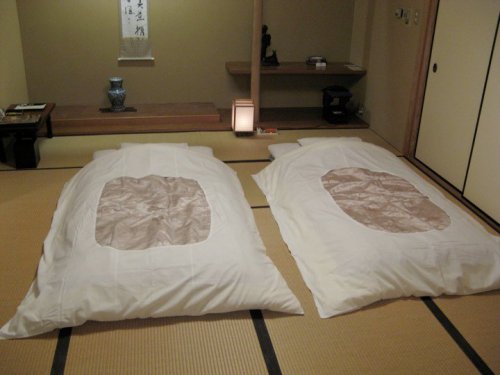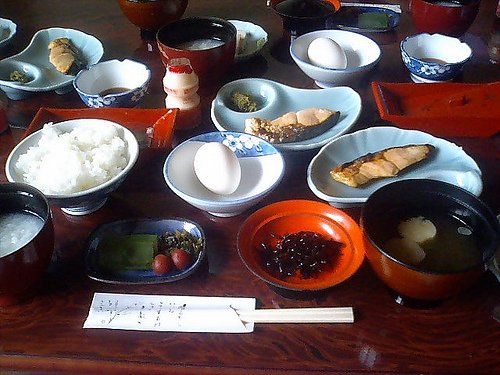Ryokan
Ryokan are the jewel in the crown of Japanese accommodation, and have been popular relaxation spots with Japan’s wealthy for hundreds of years. Nowadays they cater to everyone, and cover a huge range of prices, making ryokan some of the cheapest and most expensive places to stay in Japan. If you’ve got the budget for it, the expensive option is well worth paying for – it’s your chance to live like a feudal lord for a night or two.
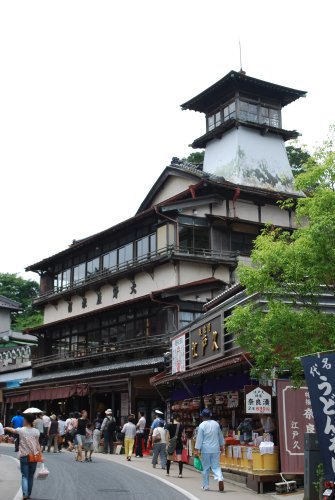
Japan has very few buildings as old as this 1935 wooden ryokan in Narita city, near Tokyo’s Narita airport
While you can use a ryokan like an ordinary hotel, you will get the most out of your stay if you treat it as a destination in itself: somewhere to revel in luxury and soak up the respect sent your way by the courteous staff, while exposing your taste buds to the most exquisite flavours they’ve ever had the privilege of sampling.
Normally you arrive at a ryokan mid-afternoon – you’ll be given a check-in time when you book – though there’s nothing to stop you arriving much later on if you so choose. Most ryokan are in resort areas out in the countryside, but they’ll often come and pick you up from the nearest station if you let them know in advance. Don’t forget to step out of your shoes and into slippers as you enter. A sign of good service is if a pair of slippers is neatly lined up for each member of your party before you arrive, and your shoes are then tidied away afterwards. At budget places you might have to do this yourself – but all ryokan provide slippers. The number one faux pas is to step inside wearing outdoor shoes – that would be just as offensive as if guests walked all over your sofa and chairs back home.
On further investigation, your room may turn out to be a suite, with it’s own living room and terrace, and perhaps even a private garden or your very own koi pond, carefully designed to instil in you feelings of harmony and relaxation. These features are particularly appreciated in Japan, where most people live in cramped and tiny flats, without a tree or any sign of nature in sight. Tea and a sweet or small snack will be served shortly after you arrive, the tea usually being in a thermos flask so that it will stay warm all evening. At this point you’ll be asked what time you’d like to have dinner. In theory you can have it at any time you want – but in practice you’ll be coaxed to select a time around 6 or 7pm. Now you should look in the cupboards until you find some yukata – one for each member of your party. You can change into them now, and continue to wear them for the remainder of your stay – not only for wearing around the ryokan but also for sleeping in – and in resort towns it’s quite normal to wear them while walking around outside too. While wearing what’s effectively a dressing gown in public may seem a bit strange, it removes the ever-present pressure to compete in the non-stop game of fashion, and is one more thing that differentiates your stay in a ryokan from your normal life – both factors that should help you to achieve a state of total relaxation.
You may be somewhat startled to find the ryokan’s staff prostrating themselves on their hands and knees – but this is just a sign of good service – so be happy that you’ve obviously chosen a quality ryokan, and otherwise take no notice. When you’re shown to your room, don’t be put out if it’s entirely empty apart from a couple of cushions and a low table – Japanese people like rooms to be uncluttered – and sitting on the floor is in no way considered inferior to using a chair – in fact, in restaurants, the more upmarket they are, the more likely it is that you will have to sit on the floor. The floor is usually covered with soft straw mats – and walking on these in slippers is almost as rude as wearing shoes indoors – so don’t forget to leave your slippers at the door. One side of the room will have a little alcove containing a decorative scroll and a flower arrangement – a typically Japanese minimalist form of decoration that contrasts with our practice of covering entire rooms in gaudy wallpaper.
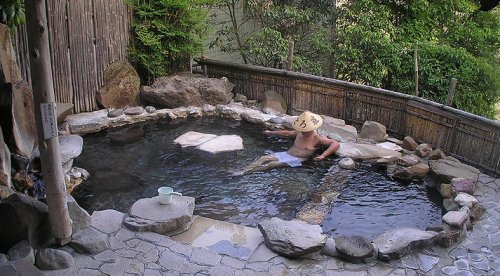
At this rotenburo in Kakogawa Onsen near Kobe, the washing area is also outside, just by the side of the bath
Now is the usual time to take a bath – and ryokan are designed to make bathing one of the highlights of your trip – it’s certainly not just a way to get clean. Some ryokan have ensuite baths in the room – an attractive option for couples – but to get the real experience I’d recommend that you head to the communal baths anyway. Nowadays there are almost always separate baths for men and women – but if you want to try ‘konyoku’ (mixed bathing), it’s not hard to find this more traditional option at older ryokans – many of which were built before any form of nudity taboo got properly established. If you do choose konyoku, you’re likely to be disappointed to find that most of the bathers are elderly – mixed bathing was the norm when they were young – so they’ve never had any qualms about showing off their bodies to the opposite sex.
On entering the changing room, you strip naked, putting your clothes in a basket, and then head into the bathroom itself, where you scrub yourself clean while sitting on a little stool – not so much for your benefit – but in order to not pollute the bath with your grime. Don’t think that the absence of privacy in the bathroom is in any way to save money – you’re as likely to encounter this set up whether you pay a few thousand or tens of thousands of yen. Bathing has long been one of the luxuries of Japanese life – a tradition stretching back hundreds of years to a time when Christians considered cleanliness sinful (one of the main reasons that Christianity never really caught on in Japan) – and it’s always been a social activity.
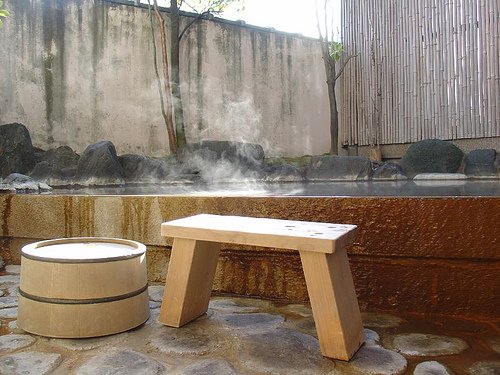
This is an ensuite private onsen – great if you're a bit shy, or would just like to share the experience with your partner
In the past it was normal to bathe in a public bathhouse every day, and while the number of bathhouses peaked around forty years ago, some remain – catering to people who would rather chat to their friends in the nude than sit in a little room all by themselves. Nonetheless, as most Japanese people nowadays bathe alone at home, communal bathing has become a special attraction to look forward to on trips away. Officially the attraction is relaxing in a really hot and spacious bath – but everyone knows that it’s really just an excuse to get naked. Nudity is seen as a way of strengthening friendships – you can’t hide anything when your whole body’s on show – and women in particular love to engage in intimate gossip when in the bath.
Tap-water baths are definitely a second-rate option – which is why so many ryokan are located near one of the thousands of onsen (natural hot springs) spread throughout the country. Onsen water comes in a variety of different colours and smells – depending on the minerals it contains. While the water is usually crystal clear, if you’re particularly shy about showing off your body, you could look around for a spring that contained blue, green, brown or even white water – giving you the chance to hide everything but your head under the surface. The catch with this is that Japanese people like their baths very hot – so you’re not likely to last too long before you have to sit half out of the water to give yourself a chance to cool off a bit. The minerals in onsen water are reputed to have all manner of health benefits. I’m somewhat doubtful about the evidential basis for most of these claims, but you’ll certainly be warmed to the core, and your skin will feel super-soft for days afterwards.
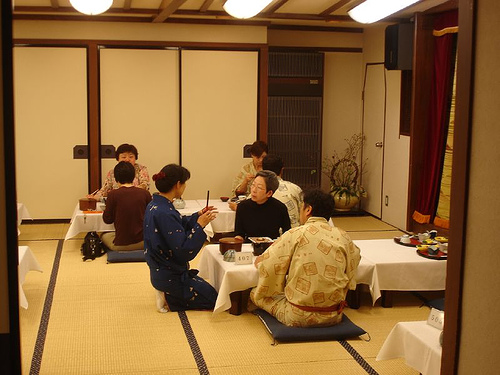
This ryokan serves dinner in a communal dining room, but some guests have still decided to wear yukata
An extra special option is the rotenburo, or outdoor bath. Often placed in a garden, alongside a stream, or overlooking a spectacular view, rotenburo provide an opportunity to get close to nature – and are often marketed as the chief attraction of a ryokan. There is something very special about lying back in comfort, surrounded by the sights and sounds of nature, as clouds of steam drift gently upwards. Best of all is taking a bath when there is snow all around – the contrast between your freezing cold streak to the bath and the heat of the water only adding to the uniqueness of the experience.
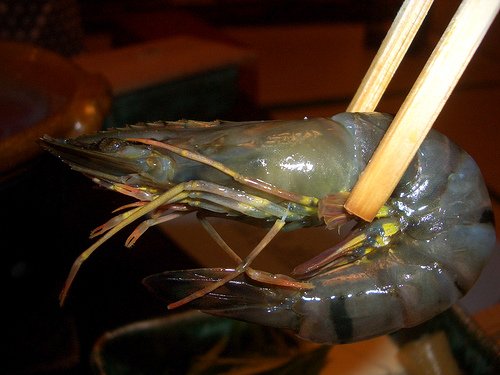
This prawn is supposed to look delicious – but it makes me shiver – seafood is one aspect of Japan that I’m completely unable to appreciate
The baths can leave you feeling a little hungry, so it’s just as well that a feast awaits on your return to your room. While nowadays lower-class ryokan make you go to the dining room, the best continue to serve meals in the privacy of your room. Choice is not something that seems to be as highly valued in Japan as it is in the West – so don’t expect to be handed a menu – an array of fine foods will simply arrive unbidden. (If you want to know what kind of food you’re going to get, you need to ask when you book.) How much you will appreciate this part of your stay depends on how brave you are about novel culinary experiences. Generally, the better quality the food the scarier it will be. My ultimate nightmare occurred once when, on lifting the lid of a table-top cooker, I found a monstrous abalone slowly flexing its muscle. It didn’t stop moving until it was almost ready to eat – cooking it alive apparently being necessary for it’s juices to circulate, something supposed to improve the flavour. My Japanese friends found it hard to understand why I found the whole experience so reminiscent of a horror film – but weren’t too put out as they got an extra abalone to share between them.
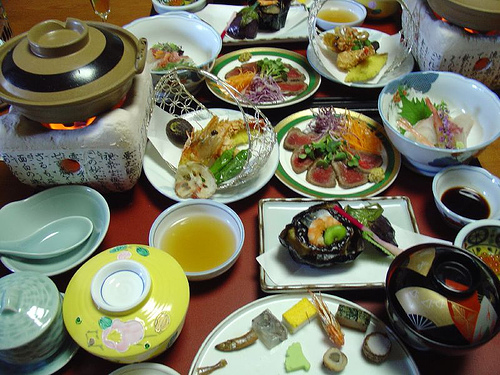
This is the kind of meal typically served in a ryokan – so be sure to leave plenty of room in your stomach
Don’t let my experience put you off – so long as you make sure they don’t serve you any seafood, the banquet should be a pleasurable rather than a traumatic experience – even in Japan land animals are always killed prior to serving. Fine Japanese cuisine consists of plate after plate of tiny morsels, so that you can sample the widest possible range of delicacies in one sitting. Most of the foods are exotic enough that it’s doubtful you’ll recognise them – and the range of flavours is likely to reach well outside of anything you’re likely to encounter in the West – even in Japanese restaurants. But if you prepare yourself for some new experiences and bravely press on, the feast is likely to be heaven for anyone with an adventurous enough palate. A quality dinner consists of ten to fifteen dishes, and breakfast about half that – though at the bottom end of the market you might just get seaweed, rice and miso soup – or even toast!
After dinner, you might want to go for a stroll outside, or perhaps for another bath – you’d be amazed at how many baths some people can fit in in one day. Many ryokan leave their onsen baths open all night to give their visitors every opportunity to make the most of them. (This isn’t a big extravagance, as the hot water is free, and flows non-stop day and night.) When you return to your room, you’ll find that it’s been transformed into a bedroom, with futons neatly laid out on the floor. This seems to be the one feature that clearly distinguishes ryokan from minshuku – as at minshuku you have to lay out your own futon. Otherwise, there’s little difference between a lower-end ryokan and a minshuku.

At the best ryokan, you can expect your room to come with a view of a beautifully maintained Japanese garden
A stay at a ryokan costs from about ¥4,500 per person without meals, up to tens of thousands of yen at luxury onsen ryokan, where the price usually includes dinner and breakfast. The Japan Ryokan Association has 1,300 member ryokan nationwide – but this represents just a fraction of the nearly 60,000 ryokan in Japan. If you’d prefer a lower cost option, a good place to start would be with the Japanese Inn Group, which also has a nationwide network. The most renowned ryokan are to be found in Kyoto, where the Sumiya, Tawaraya and Hiiragiya (all ryokan association members) retain their old wooden buildings – a real rarity in a country where concrete is king.
Business Hotel Karaoke Box

